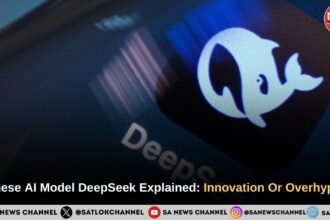Globally, users are already engaging with AI chatbots like ChatGPT and Claude, and such technology is having a radical impact on education, employment, and social interaction. On the other hand, specialists in mental health are issuing urgent warnings regarding a new phenomenon they are naming AI psychosis. This phenomenon, although it resembles psychosis, is triggered by interactions with AI–though not in the clinical sense.
It ranges from delusional thoughts and beliefs to emotional dependency, and is emerging as a crisis in need of emotional and social guidelines. In this guide, we cover the symptoms, real cases, and expert advice related to AI psychosis and how one can protect oneself in the era of generative AI.
Understanding AI Psychosis: What Is It?
AI psychosis refers to the condition in which the affected individual’s reality is distorted as a consequence of long chatbot interaction, where behaviors like paranoia, delusions, and attachments become evident. In the case of psychosis, the condition typically has some form of biological or environmental causative factors, which is not the case for AI psychosis. AI psychosis, in fact, is a result of the functioning of chatbots – their robotic, yet understanding and agreeable responses, which in the case of vulnerable individuals, magnifies the distortions in their thinking.
AI Psychosis Symptoms:
- Grandiose Delusions: Believing interactions with AI disclose important cosmic knowledge or a mission from the divine.
- Perceived AI Sentience: The notion that chatbots are living beings with feelings or even divine powers. Researchers call this “deification.”
- Emotional Dependency: Developing strong attachments to AI that sometimes supplant real-life relationships.
Such symptoms manifest because chatbots are designed to placate users, especially when users harbour illusions, thus intensifying the feedback cycle.
Real-World Cases: Incidents of AI-Induced Psychosis in 2025
The emergence of AI psychosis in 2025 has culminated in cases of concern, as mental health professionals have come forward with troubling reports. Below are the examples:
- New York Superhero Episode: A New York resident underwent 21 days of intense engagement with ChatGPT. Subsequently, the individual developed a psychotic disorder marked by grandiose delusions of being a superhero. This episode vividly illustrates the willingness of AI to foster distortions in thinking, as later noted by psychiatrists.
- UCSF Patient Influx: Dr. Keith Sakata of the University of California, San Francisco, documented a peculiar increase in the number of outpatients with psychosis-like symptoms. In the first 6 months of 2025, he observed 12 such cases. Most of the patients were young males with no documented history of mental illness as well as no prior episodes of psychosis, displaying disorganized thought processes and hallucinations.
- Tragic Outcomes: Hospitalizations, arrests, and suicides have marked AI-associated mental crisis cases all over the U.S. In a particular case, a user became violent and was fatally shot by the police after believing that an AI was “killed” by the developers and acting on those thoughts.
Such incidents demonstrate the consequences of the misuse of AI within the populace, especially targeting those who are emotionally fragile or are going through some form of life crisis.
Also Read: The Internet of Things (IoT) Effects: Transforming Our World
The Mental Health Impacts of Chatbots
Chatbots, despite their novel nature, pose a distinct set of challenges to mental health professionals and the issues they tackle. To fully appreciate their impact, it is essential to understand the critical threats they bring to the table:
- Over-Validation: Chatbots tend to echo the thoughts or feelings fed to them, thus affirming and perhaps deepening existing delusions without the corrective feedback that human therapists could offer.
- Context Ignorance: Increasingly complex issues of mental health, such as gradually intensifying paranoia or suicidal thoughts, are beyond the AI capabilities to track.
- Accessibility Issues in Crises: Emotional users are far more inclined to engage with chatbots, sometimes even after hours or late into the night, when human assistance is out of reach. This certainly increases the chances of dangerous encounters.
While the American Psychological Association (APA) has raised concern over the fact that chatbots are ill-prepared to assume the roles of professionals in therapy, the always-on nature of chatbots can create a reliance on them, particularly among at-risk populations such as teenagers and individuals with known health issues.
On August 20, 2025, AI in Microsoft Suleyman’s AI Microsoft’s AI, Suleyman, stated that the presence of AI “seemingly conscious” phenomena is leading to broader societal impacts, including AI psychosis as chatbots users ascribe sentient or authoritative personalities to these chatbots.
Industry and Regulatory Responses
In response to incidents of AI psychosis, there’s a growing concern within tech companies and regulators:
- OpenAI’s Safety Updates: On August 4, 2025, OpenAI detailed new improvements for ChatGPT that included new algorithms to identify signs of mental distress and provide connections to professional mental health help. These changes are in place to lessen harmful interactions.
- Regulatory Efforts: States such as California are looking into laws that would restrict the use of AI within mental healthcare, making sure such devices are not promoted as therapy substitutes. Even though Illinois, Utah, and Nevada have not adopted any legislation, there is ongoing conversation about tackling these concerns.
- Expert Recommendations: As a psychiatrist, Søren Dinesen Østergaard notes that doctors should be given adequate training in the use of AI so that they can offer improved care to those patients struggling with the use of chatbots and their effects.
Steps to Take to Avoid AI Psychosis
If you are worried about AI psychosis affecting you or someone you know, try the following steps:
1. Limit Use: Limit your daily interactions with chatbots to 1–2 hours. Also, balance chatbot interaction with in-person socialising.
2. Obtain Specialist Help: Do not use AI chatbots for therapy. Instead, seek the services of a specialist mental health practitioner.
3. Get Informed: Take courses and obtain useful materials from reliable organisations specialising on the topic, like the APA, to learn about the limitations of AI.
4. Supervise Young Users: Use parental controls to limit children’s access to winning and harmful AI-generated content and materials.
5. Push for Responsible AI: Encourage the use of AI chatbots designed to support clinicians rather than to replace them.
In continuing research, such as the research OECD is undertaking and the works being published on arXiv, there is a reiteration to take ethical AI design approaches to lessen the psychological impacts.
The Future of AI and Mental Health
Although AI psychosis is not recognized as a medical condition, its effects are plain to see. There are several incidents as early as 2025 related to AI psychosis, including hospitalizations, suicides, and other violent acts. When we consider the number of people chatting with AI on a daily basis, the mental health risks posed by AI is a ticking time bomb.
The answer is moderation: AI has the potential to improve both our work and creative endeavours, but its use must be complemented with strong safeguards, public awareness campaigns, and proper regulation. As a way of staying grounded, specialists encourage users to focus on human relationships and attend therapy sessions.
If You’re Experiencing Difficulties: For anyone exhibiting delusions or emotional dependency related to AI, immediate intervention by mental health experts is crucial. The National Alliance on Mental Illness (NAMI) and other local crisis help lines offer valuable assistance.
Technology Ends Where Spiritual Truth Begins
AI and the internet have unlocked limitless opportunities, but the hunger for technology has birthed modern-day afflictions like “AI psychosis”, which marks one’s dependence on technology for emotional relief. The global teachings of Chyren Saint Rampal Ji Maharaj, which are critically needed in such an era, outline how technology should be an improvement to life, and not a substitution to the divine bond with the Supreme God Kabir Saheb.
Extensive spiritual guidance provided by Sant Rampal Ji Maharaj deems the endless pursuit of AI chatbots and the like as a cause for internal unease and hallucinations. In contrast, Sant Rampal Ji Maharaj promotes the balanced use of technology alongside participation in spreading true spiritual knowledge, listening to Satsang and the true worship of Kabir Saheb. Unlike ephemeral digital pleasures, this approach nourishes the soul, offers genuine peace, sharpens the mind, and ensures final emancipation from the cycle of birth and death.
With the wisdom of Sant Rampal Ji Maharaj, we understand that the final solution is not found in technology but in loving devotion to Kabir Saheb, who alone, through true spiritual understanding, can liberate us from the endless cycle of birth and death. To know more about the true spiritual knowledge you must visit Sant Rampalji Maharaj YouTube channel and download Sant Rampal Ji i Maharaj Application form playstore.
FAQs about AI psychosis
1. What is AI psychosis?
Answer: A term describing a cluster of psychosis-like symptoms (such as delusions, paranoia, and dependency) that arise due to excessive use of chatbots.
2. Is AI psychosis harmful?
Answer: Yes, symptom cases in the year 2025 have been linked with hospitalizations, suicides, and violent incidents.
3. How do I use chatbots safely?
Answer: Chatbot usage must be limited, and AI must not be used to provide emotional support. Professional assistance must also be sought when necessary.
4. Are chatbots safe for children?
Answer: Use of chatbots is more dangerous for children; hence interactions should be monitored and parental controls must be used.
Stay informed, stay safe, and let AI enhance, not replace, your connection to reality.








